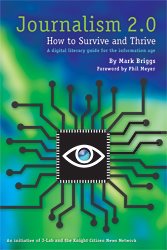
In the first chapter, Brigg’s provides readers with the essential concepts and terms necessary to thrive in the “digital age”.
The first section focuses on megabytes, gigabytes, and terabytes. According to Brigg’s,the whole digital evolution can be explained in bits and bytes. A byte is a unit of measure for digital information. A single byte contains eight consecutive bits and is capable of storing a single ASCII character.
The American Standard Code for Information Interchange (ASCII) first published a standard in 1967. It defines the 95 printable characters that are the text in computers and communications devices. Essentially, it’s everything on your keyboard: letters, numbers and basic symbols like % and &.
Why this pertains to online publishers is due to the fact that the speed of an Internet connection plus the size of the file to be downloaded determines how fast someone can download your content. Below is a diagram of the bytes and their size:

Source: Marshall Brain, “How Bits and Bytes Work,” April 1, 2000.
The second section separates the Internet from the World Wide Web. Prior to reading, I thought both terms were the same, however, as Brigg’s explains the Internet refers to the network of connected computers that share information. While, the World Wide Web refers to a way of accessing information through the Internet using the hypertext transfer protocol (HTTP) and Web browsers. It does not include other protocols such as e-mail, instant messaging and file transfer (FTP).
Briggs continues on in the chapter explaining RSS Feed, Instant Messaging and File Transfer Protocol.
RSS Feed: RSS stands for Really Simple Syndication, which is a great name because the concept is just that: Really simple. It allows you to subscribe to an information feed that gets delivered directly to your RSS reader or Web browser. So instead of visiting several different Web pages each day or performing the same Web searches over and over, you can set up RSS feeds to do it for you.
File Transfer Protocol: A simple process for moving those big files that e-mail can’t handle is called File Transfer Protocol (FTP). There are dozens of free software programs available to execute the task. Digital audio and video—and some PDF and PowerPoint files—can exceed 1MB in size. Some video files even exceed 1GB. It’s not a good idea to transfer files larger than 1MB with e-mail since most network servers are not capable of handling them. However, when would you use FTP? Use it if you have shot some photos or video or recorded some audio and you want to publish it online on your Web site with the story you are working on. All you need to transfer a large file (or files) over the Internet, besides some free software, is the account information of the server where you want to send the file.
Summary: A simple way to fine tune one’s digital literacy is to add RSS and chat daily with people using Instant Message. It will certainly open people minds to the wonderful opportunities that the Internet offers, as well as, prepare one for the changes that will occur down the road.

No Comments so far ↓
There are no comments yet...Kick things off by filling out the form below.